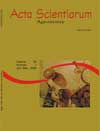<strong>Alfalfa genotype selection for adaptability and stability of dry matter production</strong> - DOI: 10.4025/actasciagron.v30i3.3511
Abstract
This work was developed with the objective of evaluating and selecting alfalfa genotypes using methods of adaptability and phenotypic stability, for the production of dry matter in harvests during the rainy and drought seasons. The experiment made use of 92 alfalfa genotypes, conducted in three environments, in randomized blocks with two replications. For analyses of the adaptability and stability of the materials, the three methods applied were the traditional methodology, the Eberhart and Russel method, as well as the centroid method. The results using the traditional method of analysis indicate that the genotype WL 612 presents the lowest variation; however, as it features low averages of dry matter production, it is not recommended for such use. Applying the Eberhart and Russel methodology, LE N 4 had the best adaptability of dry matter production. Using the centroid method, several genotypes displayed overall adaptability; however, LE N 4 and P 30 were closest to centroid 1. The genotypes with the best behaviors in wet environments were Rocio and Costera SP INTA and, in the drought period, Bacana performed the best. Genotype LE N 4 showed the best overall adaptability, and genotype Bacana can be an option for utilization in the drought period.Downloads
Download data is not yet available.
Published
2008-05-27
How to Cite
Vasconcelos, E. S. de, Barioni Júnior, W., Cruz, C. D., Ferreira, R. de P., Rassini, J. B., & Vilela, D. (2008). <strong>Alfalfa genotype selection for adaptability and stability of dry matter production</strong> - DOI: 10.4025/actasciagron.v30i3.3511. Acta Scientiarum. Agronomy, 30(3), 339-343. https://doi.org/10.4025/actasciagron.v30i3.3511
Issue
Section
Genetics and Plant Breeding
DECLARATION OF ORIGINALITY AND COPYRIGHTS
I Declare that current article is original and has not been submitted for publication, in part or in whole, to any other national or international journal.
The copyrights belong exclusively to the authors. Published content is licensed under Creative Commons Attribution 4.0 (CC BY 4.0) guidelines, which allows sharing (copy and distribution of the material in any medium or format) and adaptation (remix, transform, and build upon the material) for any purpose, even commercially, under the terms of attribution.
2.0
2019CiteScore
60th percentile
Powered by 

2.0
2019CiteScore
60th percentile
Powered by 



















































